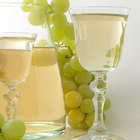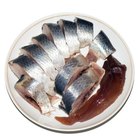Wine is mysterious and unpredictable. Although these qualities have created an enormous worldwide fan club, it does make an initial tasting a bit of a challenge. Wine lovers know that wine labels don’t always tell you the whole story. Use these tips--and your senses--to determine if a wine is dry, sweet or somewhere in the middle.
Know the basics.
Dry wine is au natural--just the natural fermenting of a grape. Sweet wine, on the other hand, is fortified with additives that stop the sugar in the grapes from turning completely to alcohol. Therefore, sweet wines taste more honeyed because they have a higher level of residual sugar, while dry wines are less candied because the grape has been allowed to fully ferment and there is more acidity and alcohol content to offset the wine sweetness. Semi-sweet wines fall somewhere in the middle of this fermentation process and the amount of residual sugar and thus sugar content in them falls in the middle, giving a pleasant sweetness level for wine drinkers.
Consider the type of wine you are tasting.
Sauternes, Chablis and Riesling are considered dry white wines, while Claret, Burgundy and Chianti are considered dry reds. On the other hand, Port, sherry, Muscat and Tokay are considered to be the sweetest wines on the market – these are known as dessert wines. Well-known varieties such as cabernet sauvignon, merlot and chardonnay can be sweet or dry, depending on the type of grape growth, additive and region. Grape varieties, climate, and the winemaking process all impact the sugar level and flavor profile of each individual wine, so although you can follow the rules of thumb, keep in mind that every bottle is different.
Smell the wine.
By sticking your face into the wine glass, you can pick up the "nose" of the wine. This will help you determine if the wine is sweet or dry. If you pick up scents of sugar, fruit or honeysuckle, you are probably dealing with a sweet wine. However, if you detect herbs, spices, wood or yeast, you have a drier wine. Be careful--some wines can carry scents of trickery, such as chocolate and citrus, which offer no indication as to whether the varietal will be dry or sweet.
Taste the wine.
Your best indicator as to a wine’s dryness is your tongue. Sip wine, let it rest on your tongue, swirl it around in your mouth, then swallow and wait for an aftertaste. A dry wine usually has a stronger taste on the tongue, but a clean finish. You will often taste the tannins in red wine up front, as well as any fruity flavors on your taste buds. The taste of a sweet wine, on the other hand, tends to linger in your mouth for a moment after you have swallowed the liquid.
Utilize the tasting notes.
It is sometimes difficult to determine the flavors in a wine. A wine that is supposed to be very dry may taste quite sweet on your tongue. Notes can help you discern among the many flavors. For example, reading about "hints of lemon and honey," may help you better pinpoint specific flavors that you didn't know you were looking for. Off-dry vs. bone dry wines have generally different flavor notes, and sparkling wines have different notes all together. In no time, you’ll be able to differentiate a sauvignon blanc from a moscato, and a pinot noir from a malbec or zinfandel.
Related Articles

Red Wines That are Considered Dry

What Is the Primary Difference Between ...

Qualities of a Good Wine

Why Does Wine Not Expire?

Types of Bacteria in Wine

What Wine Do You Pair With Chinese ...
Calories in Charles Shaw Wine

How Long Should a Wine Collector Keep a ...

Types of Amber Wine

List of the Different Types of Champagne

How to Use Bentonite for Clearing Wine

Does Yeast Turn Juice to Alcohol?

How to Reduce Wine With Sugar to a Glaze

How to Store Cognac

Herring in Wine Sauce

What to Substitute for Mirin

How to Enjoy a Chianti Wine

Why Is White Wine Turning Brown in a ...

Red Wines That Need to Be Chilled

Can I Make Sangria From White Zinfandel?
Tips
- Test the consistency of a wine by swirling the body around in your glass. Sweet wine usually has a thicker, more syrupy consistency, which causes it to take longer to fall down the side of the glass. Drier wines won't linger on the glass walls.